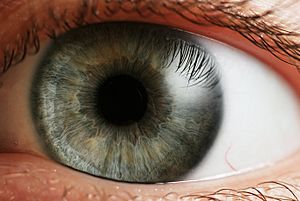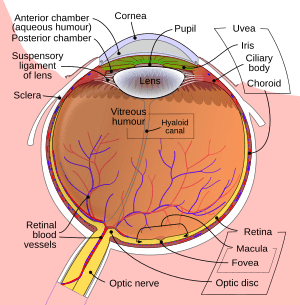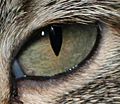Pupil (eye) facts for kids
The pupil is the dark opening in the center of your eye. It's like a tiny window that lets light into your eye. This light then goes through the lens, which helps to focus what you see onto the retina at the back of your eye.
Tiny muscles around the pupil control its size. One set of muscles makes the pupil smaller, and another set makes it bigger. When it's dark, your pupils get larger (this is called dilating) to let in more light, helping you see better. When it's very bright, your pupils get smaller (this is called constricting) to limit the amount of light, protecting your eyes and helping you see clearly. You can think of the pupil like the shutter on a camera, adjusting how much light gets in. The pupil is surrounded by the iris, which is the colorful part of your eye.
The lens inside your eye also changes shape. It does this to help your eye focus on things that are close or far away. The pupil usually looks black in most animals. This is because the light that enters is absorbed by the tissues inside the eye. In humans, pupils are round. But in some other animals, like cats, they can be shaped like a slit!
Contents
How Pupils Show Your Health
Your pupils can tell us a lot about how healthy a person's brain is. Doctors often check pupils to understand what's happening inside the body.
Pupil Size
Normal pupils are usually about 4 millimeters wide. When pupils are a normal size, doctors call them "regular."
If both pupils are very tiny, like the tip of a pin (about 1 mm wide), it can be a sign of a few things:
- Someone might have been poisoned by certain chemicals, like some pesticides or even nerve gases.
- It could also be a very rare sign of bleeding in a specific part of the brainstem.
Your pupils can also get smaller if you are in very bright light.
If both pupils are much larger than usual (up to 8 mm wide), it can be a sign that:
- The person's brain is not getting enough oxygen (this is called hypoxia).
- It can also be a sign of a very serious medical condition.
Your pupils will also get larger if you are in a dark room or if you have used certain eyedrops.
Are Pupils Equal?
In most healthy people, both pupils should be the same size. Doctors call this "equal." If one pupil is bigger than the other, it usually means something might be wrong with the brain. For example, the brain might be injured, or the person might have had a stroke.
However, it's interesting that up to 20% of healthy people naturally have pupils that are slightly different sizes. For these people, it's completely normal and doesn't mean there's a problem. The difference in size is usually small.
Pupil Shape
Healthy pupils are always round. If a pupil has a different shape, it usually means the eye itself has been injured.
How Pupils React to Light
When a light is shined into one pupil, both pupils should get smaller at the same time. When the light is taken away, both pupils should get bigger again at the same time. This is called being "light-reactive," meaning the pupils react to changes in light.
- If both pupils change size together, but they do it slowly, they are called "sluggish." This can be a sign of illegal drug use, not enough oxygen getting to the brain (hypoxia), or an injury.
- If only one pupil changes size, there is usually a problem with the brain or with the optic nerve (the nerve that connects the eye to the brain).
- If neither pupil changes shape when light is shined on it, the pupils are called "fixed." This is a sign of a very serious brain problem. The brain is supposed to control pupil changes, so if it's not happening, it means the brain isn't working normally. When someone is in a coma or has passed away, their pupils will often be both fixed and large (dilated).
What Healthy Pupils Look Like
Since the brain controls the pupils, healthy pupils are a good sign of a healthy brain. Medical experts use a special abbreviation to describe healthy pupils: PERRL.
- Pupils are
- Equal (the same size)
- Round
- Regular (normal size)
- Light-reactive (they react to light)
Images for kids
-
A crocodile with vertical slit pupils
-
A cuttlefish with W-shaped pupils
-
A gecko with 'string of pearls' pupils
-
A cat with vertical slit pupils
-
Young grasshopper, with eyes so well camouflaged that they can hardly be seen
See also
 In Spanish: Pupila para niños
In Spanish: Pupila para niños










